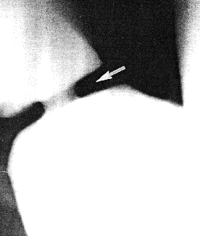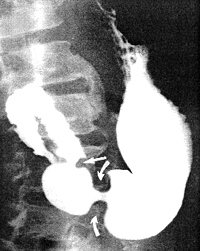



Go to chapter: 1 | 2 | 3 | 4 | 5 | 6 | 7 | 8 | 9 | 10 | 11 | 12 | 13 | 14 | 15 | 16 | 17 | 18 | 19 | 20 | 21 | 22 | 23 | 24 | 25 | 26 | 27 | 28 | 29 | 30 | 31 | 32 | 33 | 34 | 35 | 36 | 37 | 38 | 39
Chapter 13 (page 56)
Details of the contractions of the distal 3.0 to 4.0 cm of the stomach, as seen
radiologically, have been documented (Keet l957, l962). While the descriptions remain
valid, room exists for minor modifications and further clarification. Moreover, in the
previous descriptions only maximal (or complete) contractions, i.e. those bisecting the
lumen, were considered; in the present investigation the more shallow (or incomplete)
contractions will also be dealt with. Consequently the following additional studies have
been done.
The contractions were studied in (1) the group of 100 adult, ambulatory outpatients
mentioned in Chap. 12; (2) a group of 20 patients in whom previous endoscopic
examinations had proved the oesophagus, stomach and duodenum to be normal. (These
patients had been referred for radiographic studies to confirm the absence of hiatus
hernia).
Each patient had a conventional upper gastrointestinal barium study, the contractions
being observed in both the erect and supine positions. As people generally have meals in
a sitting position, studies were also performed with the subject sitting in 5 of the 20
endoscopically normal cases. Localized "spot" exposures were done occasionally for
record purposes.
Ethical Considerations.
As the contractions were studied during the ordinary course of events, the examinations
were not prolonged to any appreciable extent, which means that any possible extra
radiation to the patient was negligible.
Irrespective of the position of the patient, definite "patterns" of contraction occurred.
In all 120 cases a stage was awaited in which the duodenal cap was filled, in which the
normal division between the stomach and duodenum (the pyloric ring) was clearly
visible, and in which the pyloric region as well as the duodenal bulb were free of
contractions, i.e. a motor quiescent phase (Fig. 11.1, 11.2). Measurements at this stage
showed that the width of the normal indentation between the stomach and duodenum (the
pyloric ring) on the lesser curvature, was more or less equal to the width on the greater
curvature (Fig. 13.5) (see also Fig. 11.1 and 11.2). At this stage it is also seen that the
pyloric aperture is patent, that it contains barium and that its diameter can be measured.
 |
Fig. 13.5.
Normal pyloric ring (arrow) in motor quiescent phase. Width of ring on lesser
curvature more or less equal to that on greater curvature. Note patent pyloric aperture
with diameter of 9 mm, containing barium
|
After a variable interval peristaltic contractions commenced in the gastric corpus in all
cases. These narrow, annular waves were seen to proceed along the body of the stomach
in a caudal direction as far as a point 3.0 to 4.0 cm proximal to the pyloric aperture. At
this point each caudally travelling peristaltic wave came to a halt, i.e. it failed to advance
any further, and ended in a concentric or cylindrical contraction of the entire distal 3.0 to
4.0 cm of the stomach (Fig. 13.6).
 |
Fig. 13.6.
Point at which peristaltic wave stops (curved arrows). Pyloric aperture
(straight arrow). The region between the curved and straight arrows is distal 3-4 cm of
stomach.
|
Previous Page | Table of Contents | Next Page
© Copyright PLiG 1998








